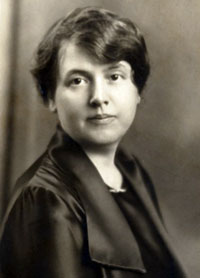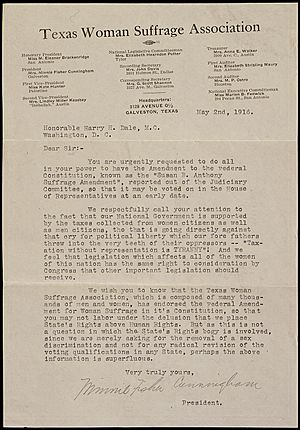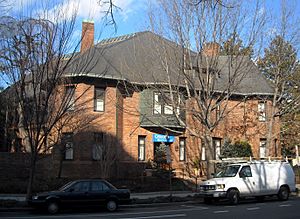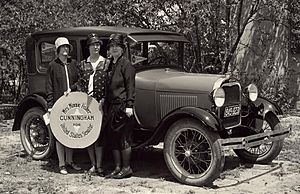Minnie Fisher Cunningham facts for kids
Quick facts for kids
Minnie Fisher Cunningham
|
|
|---|---|
 |
|
| Born | March 19, 1882 |
| Died | December 9, 1964 (aged 82) New Waverly, Texas, US
|
| Known for | Suffragist Politician First Exec Secretary League of Women Voters |
| Spouse(s) | B. J. Cunningham |
Minnie Fisher Cunningham (March 19, 1882 – December 9, 1964) was an American politician who fought for women's rights. She was a key leader in the movement to get women the right to vote, also known as suffrage. Minnie was the first executive secretary of the League of Women Voters, an important group that helps people understand politics. She also worked hard to pass the Nineteenth Amendment to the United States Constitution, which finally gave women across the country the right to vote.
Minnie was also one of the people who helped start the Woman's National Democratic Club. This club is a place for women interested in politics. She managed the club's money and helped them buy their main building in Washington, D.C., which is still used today.
Minnie's family had been wealthy, but they lost their money after the American Civil War and a period called Reconstruction. This meant her mother had to sell vegetables to support the family. Minnie made history as the first female student to earn a pharmacy degree from the University of Texas Medical Branch in Galveston, Texas.
She was a member of the National American Women's Suffrage Association. This group worked to convince leaders to support women's voting rights. Minnie even met with President Woodrow Wilson and helped persuade him to support women's suffrage. When Texas Governor James E. Ferguson tried to stop the Nineteenth Amendment, Minnie helped lead a group that worked to remove him from office.
Minnie was active in politics for many decades in Texas and across the country. In 1928, she became the first woman from Texas to run for the United States Senate. She supported Franklin D. Roosevelt's New Deal programs, which aimed to help people during tough economic times. Minnie also saw how poverty and poor food were connected. She worked to pass laws that would make sure flour and bread had important nutrients. In 1944, she ran for governor of Texas and came in second place out of nine candidates. She even sold used clothes to help fund John F. Kennedy's presidential campaign office in her hometown.
Contents
Early Life and Education
Minnie Fisher was born on March 19, 1882, in New Waverly, Texas. She was the seventh of eight children. Her parents were Horatio White Fisher and Sallie Comer Abercrombie Fisher. Minnie's family had once owned a lot of land and slaves. But after the American Civil War and Reconstruction, they lost their wealth.
Minnie and her siblings grew up on her grandparents' plantation. Instead of slave labor, the family now used sharecroppers. Minnie's mother, Sallie, taught the children at home until 1894. The family started a business selling vegetables to railroad workers. They eventually sold their produce in Houston. Sallie used the money from this business to pay for her children's formal schooling.
Minnie was a Methodist and helped start a Methodist church in New Waverly. After the 1900 Galveston hurricane in 1900, Minnie and her mother helped raise money for people affected by the storm. Minnie's interest in politics came from her father.
Even though she could have been a teacher, Minnie chose to study medicine. She went to the University of Texas Medical Branch in Galveston, Texas to study pharmacy. In 1901, Minnie was the only woman to earn a pharmacy degree from her school. She found a job in Huntsville, Texas, but she earned less than half of what her male co-workers made, even though they had less education. Minnie later said this experience made her want to improve the lives of women.
Fighting for Women's Vote
After marrying B. J. Cunningham in 1902, Minnie started volunteering. In 1912, she joined the Wednesday Club, which focused on women's right to vote and children's rights. She also joined the Women's Health Protective Association and the Galveston Equal Suffrage Association. In these groups, Minnie became a skilled public speaker. She gave speeches at events and to lawmakers.
Minnie became involved with the Texas Woman Suffrage Association (TWSA). In 1913, this group joined the National American Women's Suffrage Association (NAWSA). In 1914, Minnie was elected president of the Galveston Equal Suffrage Association. She connected with other important suffrage leaders. Under her leadership, the Galveston group held public events with speeches from famous activists.
Minnie also reached out to labor union leaders. In 1915, she wrote five articles about women's suffrage for a labor newspaper. She worked hard to get the Texas State Legislature to change the state constitution to allow women to vote. Even though this change didn't pass, Minnie kept working tirelessly.
In 1915, Minnie was elected president of the TWSA. She led the group until 1919. In 1916, the TWSA changed its name to the Texas Equal Suffrage Association (TESA). Minnie focused on how to keep the organization running financially. She often used her own money to fund TESA and even ran the group from her home.
Challenging Governor Ferguson
Texas Governor James E. Ferguson and former Senator Joseph Weldon Bailey strongly opposed women's right to vote in 1916. They said it was a "states' rights" issue, meaning states should decide, not the federal government. Minnie led a protest against Governor Ferguson at a national political meeting. When she returned to Texas, she traveled around the state, urging people to vote against Ferguson.
In 1917, Minnie moved the TESA office to Austin. This was because the Texas Legislature was considering a bill that would allow women to vote in primary elections. At the same time, there was talk of removing Governor Ferguson from office. He was accused of misusing money and making bad appointments at the University of Texas. Minnie joined with others to form the Women's Campaign for Good Government. This group sent many letters and telegrams to lawmakers. They also handed out flyers listing Ferguson's wrongdoings. Ferguson was removed from office for ten reasons and was not allowed to hold office in Texas again. He resigned on August 25, 1917.
During World War I, Minnie involved TESA in patriotic work, like selling war bonds. The group also worked to provide good activities for soldiers near military bases. In 1918, Minnie was appointed to the Texas Military Welfare Commission.
Even though he was banned from office, Ferguson announced he would run for governor again in 1918. Minnie worked with a state representative to make a deal. If he could get a bill passed that allowed women to vote in primary elections, she would get women to vote for the acting governor, William P. Hobby. The bill passed, and Governor Hobby signed it on May 26. Women then formed "Women's Hobby Clubs" to deliver on their promise. Their votes helped Annie Webb Blanton win her election. She became the first woman in Texas elected to a statewide office.
Winning the 19th Amendment
In 1917, Minnie arranged a meeting in Washington, D.C. for women to share their views on the proposed women's suffrage amendment. She and another leader started a campaign to have people send many telegrams to their representatives, asking them to support the amendment. The United States House of Representatives passed the first version of the Nineteenth Amendment in January 1918, but it failed in the United States Senate.
Minnie also worked with a university professor to pressure Texas newspapers to write articles supporting the amendment. They sent these articles daily to a senator who was against suffrage.
Minnie was asked to lobby, or persuade, Senator Andrieus Aristieus Jones of New Mexico. He was the head of the Senate Woman Suffrage Committee. She convinced him to bring the amendment up for a vote. Minnie was also part of a team that met with President Woodrow Wilson. They successfully convinced him to say he supported women's right to vote.
In January 1919, the Texas state legislature passed a state amendment for full women's suffrage. However, it had to be approved by state voters and failed. The Nineteenth Amendment to the United States Constitution was passed by the U.S. House of Representatives on May 21, 1919, and by the U.S. Senate on June 4, 1919. Minnie immediately began campaigning for Texas to approve it. Texas became the first southern state to do so on June 28, 1919. Minnie then traveled across the country to encourage other states to ratify the amendment. The necessary 36 states approved the amendment by August 26, 1920, making it law.
Leading the League of Women Voters
Once the Nineteenth Amendment was passed, the National American Women's Suffrage Association became the League of Women Voters (LWV). Minnie was chosen as a delegate to the Democratic National Convention in 1920. The Texas Equal Suffrage Association also became the Texas League of Women Voters in 1919.
Minnie was asked to work with other leaders to pass the 1921 Sheppard-Towner Maternity and Infancy Act. This law aimed to lower the number of babies who died. As the executive secretary of the LWV, Minnie worked to get individual states to accept this law. She also worked on the 1922 Married Women's Independent Citizenship Act. Before this law, a woman's citizenship depended on her husband's. This new law meant a woman's citizenship was based only on her own status.
Minnie also helped organize a big meeting in 1922 that combined the LWV convention with the Pan-American Conference of Women. This conference brought together important women from across the Americas. It led to the creation of the Pan-American Association for the Advancement of Women.
Her Political Career
In 1924, Minnie led the LWV's "Get Out The Vote" campaign, traveling to several states. This was her last official role with the LWV. She then joined a Democratic Women's Advisory Committee. Minnie started to believe that women needed to be more involved in political parties.
In 1924, former Texas Governor James E. Ferguson, who couldn't hold office himself, put his wife, Miriam A. Ferguson, forward as a candidate for governor. Minnie decided to support the Republican candidate instead. Minnie also worked on prison reform in Texas. She hoped to change the practice of making prisoners work on cotton plantations.
Minnie was one of the people who helped start the Woman's National Democratic Club. This club was formally opened in 1924.
Running for U.S. Senate
In 1928, Minnie ran to represent Texas in the United States Senate. She was the first woman in Texas to do so. Her main goal was to raise the importance of women in elections. She focused on important issues rather than fighting with her opponents. Minnie lost in the primary election.
Supporting the New Deal
In 1930, Minnie became an editor at the Texas Extension Service. She became interested in how poverty was linked to poor nutrition. In 1939, she started working for the Agriculture Adjustment Administration. Minnie worked with women's clubs to ask bakers to add vitamins and minerals to flour and bread.
In 1938, she formed the Women's Committee for Economic Policy. This group worked with Lyndon B. Johnson in his 1941 Senate campaign. They agreed to get votes for him if he made freight-rate reform a priority. The group also supported better retirement systems for teachers and pensions for elderly people in need. Minnie became frustrated with government policies that went against the New Deal, so she resigned in 1943 and returned to Texas.
1944 Campaign for Governor
After returning home, Minnie ran for governor in 1944. She wanted to oppose Governor Coke Stevenson, who she believed was trying to undermine President Roosevelt's price controls. She was especially upset that he cut pensions for the elderly. Minnie and other Texas liberals tried to convince another person to run against Stevenson, but they couldn't.
Minnie had little money for her campaign. She sold lumber from trees on her family's farm to pay her filing fee. Even though she lost in the primary, Minnie came in second place out of nine candidates. Her campaign helped bring together liberals in Texas.
Later Years and Legacy
Minnie continued to be involved in politics. She helped create a farm labor organization called the Texas Social and Legislative Conference. This group worked to bring together different parties who supported New Deal policies. Minnie continued to support the Democratic Party, including Harry S. Truman in 1948.
When Texas Governor Beauford H. Jester died in 1949, Lieutenant Governor Allan Shivers became governor. Shivers led a group within the Texas Democratic Party who wanted to support the Republican candidate, Dwight D. Eisenhower, in 1952. Minnie and another leader ran the "Texas Women for Stevenson" organization. In 1953, Minnie started the Texas Democratic Women's State Committee. This group supported the national Democratic Party and included minorities and liberals who felt left out by Shivers' group.
Since 1944, Minnie had written a column called "Countryside and Town" in a newspaper. She believed liberals needed their own media to share their ideas. In 1954, she tried to buy the newspaper by mortgaging her farm, but the owner refused to sell to her. Instead, she and a friend arranged to merge two papers, and with funding from Frankie Carter Randolph, the paper was renamed The Texas Observer.
In 1958, Texas Democrats held events to honor Minnie's contributions. Minnie was an invited guest at the inauguration of President John F. Kennedy. This was a thank you from Kennedy for her help in his 1960 campaign. She had set up a campaign office for him in her hometown, which she paid for by selling used clothing.
Personal Life and Death
Minnie Fisher married insurance executive Beverly Jean (B.J.) Cunningham on November 27, 1902. Her husband became County Attorney in 1904. They moved to Houston in 1905 and then to Galveston in 1907 for his work. B.J. died on March 20, 1928.
Minnie's father died in 1906. After his death, Minnie's mother lived with her other daughter and son-in-law at Fisher Farms. After women gained the right to vote, Minnie moved in to help care for her mother. Between jobs, Minnie often returned to Texas to be a full-time caregiver for her mother. Sallie Fisher died in 1930.
Minnie continued to be active, but her health declined in her final years. She had heart problems and broke her hip in 1964. Minnie Fisher Cunningham died on December 9, 1964, from heart failure. She was buried in the Hardy Cemetery in New Waverly, Texas.




